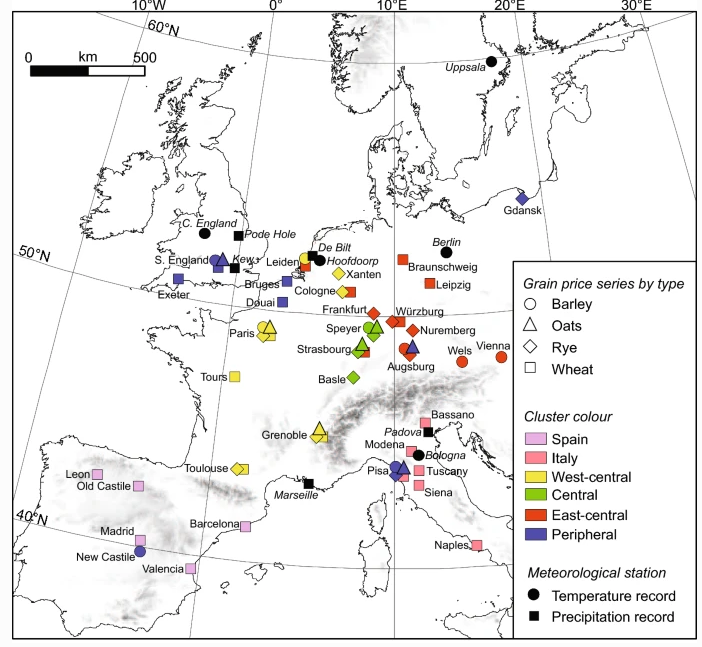European grain prices from 1500 – 1800 varied with temperature: falling in warm years and rising in colder ones. Precipitation and solar cycles on the other hand had almost no influence on grain prices.
Hat-tip: Klimaschau
A recent scientific publication titled “The significance of climate variability on early modern European grain prices” by a team of scientists led by Fredrik Charpentier Ljungqvist looked at the extent to which climate variability determined grain price across Europe from the years 1500–1800.
The researchers analyzed the relationship between instrumental and reconstructed temperature, solar activity and hydroclimate variability on the grain price variations each year.
A highly significant negative grain price–temperature relationship (i.e. colder = high prices and vice versa) is found across Europe. The authors found this association increases at larger spatial and temporal scales and reaches a correlation of −0.41 considering the European grain price average and previous year June–August temperatures at annual resolution, and of −0.63 at decadal timescales. This strong relationship is of episodic rather than periodic (cyclic) nature.
Location of the included grain price data (coded after grain type and cluster assignment) as well as the location of the instrumental temperature and precipitation station records. Source: Springer Verlag, Ljungqvist, F. C. et al.
The biggest factor on grain prices was temperature. The result: Prices were generally inversely proportional to the temperature. The cooler the temperature were, the higher the prices were for grains. History shows that warmer temperatures are good, cooler temperatures are bad and lead to more hunger. During warmer years, harvests were more plentiful and so prices were lower.
Somewhat surprising was the grain price impact from precipitation and sunspot activity. Here the authors found that precipitation and sunspot activity played a far lesser role on grain prices than temperature. The paper’s abstract:
Only weak and spatially inconsistent signals of hydroclimate (precipitation and drought), and no meaningful association with solar variations, are detected in the grain prices. The significant and persistent temperature effects on grain prices imply that this now rapidly changing climate element has been a more important factor in European economic history, even in southern Europe, than commonly acknowledged.”






Hold on. Is this suggesting that the massive grain crops produced in Australia are a result of the warm climate here?
Similar information in this:
The Structures of Everyday Life: Civilization and Capitalism,
15th-18th Century Volume 1 [English, French (translation)]
by Fernand Braudel
In warmer climates people tend to feel more comfortable and have more “free time” to exercise other activities(including mental) than in colder climates, in which much more time is required to survive (stay warm, find food etc).
As a result cultures tend to bloom in the more warmer parts of this earth, as history shows. Example: The Vikings went South not North.
How difficult is this to understand?
[…] Learn extra at No Methods Zone […]